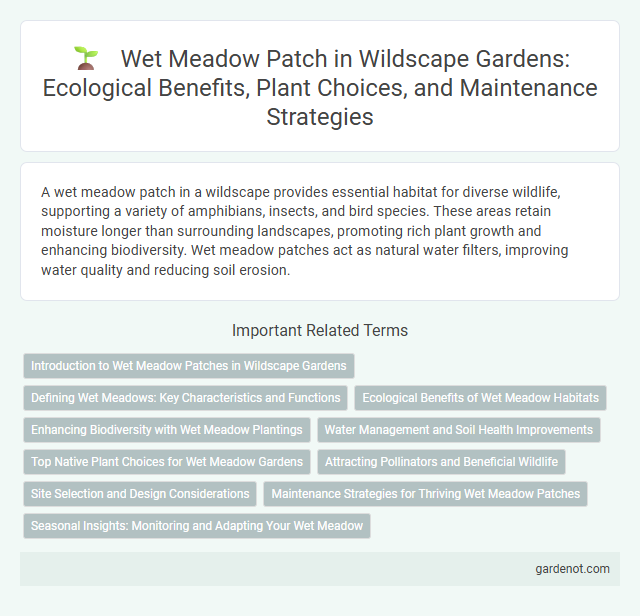A wet meadow patch in a wildscape provides essential habitat for diverse wildlife, supporting a variety of amphibians, insects, and bird species. These areas retain moisture longer than surrounding landscapes, promoting rich plant growth and enhancing biodiversity. Wet meadow patches act as natural water filters, improving water quality and reducing soil erosion.
Introduction to Wet Meadow Patches in Wildscape Gardens
Wet meadow patches in Wildscape Gardens provide critical habitats for diverse plant species, including sedges, rushes, and wildflowers, supporting pollinators and wildlife. These wetlands regulate water flow, reduce erosion, and improve water quality by filtering runoff. Integrating wet meadow patches enhances biodiversity and creates resilient ecosystems within the garden landscape.
Defining Wet Meadows: Key Characteristics and Functions
Wet meadows are seasonally saturated ecosystems characterized by herbaceous vegetation, saturated soils, and periodic flooding that support diverse plant and animal species. These habitats play critical roles in water filtration, flood mitigation, and providing breeding grounds for amphibians and pollinators. Their hydrology and soil conditions distinguish them from other wetlands such as marshes and swamps, making them essential components of wetland conservation efforts.
Ecological Benefits of Wet Meadow Habitats
Wet meadow patches support biodiversity by providing critical habitats for amphibians, pollinators, and waterfowl. These ecosystems improve water quality through natural filtration and enhance groundwater recharge by retaining surface runoff. Their dense vegetation stabilizes soil, reducing erosion and promoting nutrient cycling within the wildscape.
Enhancing Biodiversity with Wet Meadow Plantings
Wet meadow patch plantings significantly enhance biodiversity by providing essential habitats for diverse wildlife, including pollinators, amphibians, and ground-nesting birds. Native wet meadow plants improve soil health and water retention, supporting a balanced ecosystem while reducing erosion. Species such as Joe-Pye weed, swamp milkweed, and blue flag iris thrive in these conditions, fostering ecosystem resilience and promoting native flora proliferation.
Water Management and Soil Health Improvements
Wet meadow patches in Wildscape play a crucial role in water management by enhancing natural water retention and reducing runoff, which mitigates flooding risks. These areas promote soil health improvements through increased organic matter decomposition and nutrient cycling, fostering robust microbial communities. The combination of moisture regulation and enriched soil structure supports diverse plant species, contributing to ecosystem resilience.
Top Native Plant Choices for Wet Meadow Gardens
Wet meadow gardens thrive with native plants such as Swamp Milkweed (Asclepias incarnata), Blue Flag Iris (Iris versicolor), and Joe-Pye Weed (Eutrochium purpureum), which provide essential habitat and support local pollinators. These species tolerate saturated soils and fluctuating water levels, making them ideal for wet meadow patches in Wildscape designs. Incorporating these top native plants enhances biodiversity and ensures a resilient, ecologically balanced garden ecosystem.
Attracting Pollinators and Beneficial Wildlife
Wet meadow patches provide essential habitats that attract a diverse range of pollinators including bees, butterflies, and hoverflies, which play a crucial role in ecosystem health and plant reproduction. Native flowering plants in these areas offer abundant nectar and pollen resources, supporting beneficial wildlife such as predatory insects and amphibians that help control pests naturally. Maintaining wet meadow biodiversity enhances ecological balance and promotes a resilient, thriving wildscape environment.
Site Selection and Design Considerations
Selecting a wet meadow patch for a wildscape requires assessing soil moisture levels, native vegetation compatibility, and proximity to water sources to ensure sustainable habitat conditions. Design considerations include creating gentle slopes for proper drainage, incorporating a diversity of native grasses and flowering plants to support pollinators and wildlife, and maintaining seasonal water fluctuations to mimic natural hydrology. Proper site selection combined with thoughtful design enhances biodiversity, promotes ecosystem resilience, and supports native wetland species.
Maintenance Strategies for Thriving Wet Meadow Patches
Effective maintenance of wet meadow patches in Wildscape involves regular monitoring of soil moisture and nutrient levels to support native plant growth. Controlled seasonal mowing and selective grazing prevent invasive species while promoting biodiversity and habitat health. Implementing adaptive water management ensures consistent hydrology, critical for maintaining the wet meadow ecosystem's resilience and ecological functions.
Seasonal Insights: Monitoring and Adapting Your Wet Meadow
Seasonal monitoring of a wet meadow patch reveals critical insights into water levels, plant growth stages, and wildlife activity, enabling tailored management practices that enhance biodiversity. Early spring assessments identify key native flora emergence, while late summer evaluations track invasive species encroachment and soil moisture fluctuations. Adapting maintenance routines based on these seasonal changes supports the wet meadow's ecological resilience and long-term habitat health.
Wet meadow patch Infographic

 gardenot.com
gardenot.com